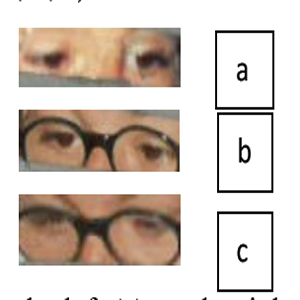Kearns-Sayre syndrome with optic nerve atrophy phenotype: A possible biological and clinical concurrence of two mutations?

Accepted: January 30, 2022
All claims expressed in this article are solely those of the authors and do not necessarily represent those of their affiliated organizations, or those of the publisher, the editors and the reviewers. Any product that may be evaluated in this article or claim that may be made by its manufacturer is not guaranteed or endorsed by the publisher.
The authors report about the association of progressive external ophthalmoplegia, atypical pigmentary retinopathy, ataxia phenotype with onset in first months of life (Kearns-Sayre syndrome) and with optic nerve atrophy and deafness. The localization of retinal lesions was coincident with that reported by multifunctional electroretinogram (mfERG) in OPA 1 mutation. The authors hypothesize that Kearns-Sayre mitochondrial mutation may be associated with OPA 1 missense mutation, with worsening of symptomatology, as occurs in the reported case. The prolonged rehabilitation and treatment with coenzyme Q10 for many years gave positive results, with amelioration of ophthalmoplegia, stopping of aggravation of retinal damage and optic nerve atrophy, maintaining of vision some meters away, possibility of socialization and proprioceptive ability amelioration.
Leonard JV, Schapira AHV. Mitochondrial respiratory chain disorders II: neurodegenerative disorders and nuclear gene defects. Lancet 2000;355:389-94. DOI: https://doi.org/10.1016/S0140-6736(99)05226-5
Kearns TP, Sayre GP. Retinitis pigmentosa, external ophthalmoplegia, and complete heart block: unusual syndrome with histologic study in one of two cases. AMA Arch Ophthalmol 1958;60:280-9. DOI: https://doi.org/10.1001/archopht.1958.00940080296016
Kerrison JB, Arnould VJ, Ferraz Sallum JM, et al. Genetic heterogeneity of dominant optic atrophy, Kjer type: Identification of a second locus on chromosome 18q12.2-12.3. Arch Ophthalmol 1999;117:805-10. DOI: https://doi.org/10.1001/archopht.117.6.805
Di Mauro S, Schon EA. Mitochondrial respiratory-chain diseases. N Engl J Med 2003;348:2656-68. DOI: https://doi.org/10.1056/NEJMra022567
Mishra R. Kearns Sayer Syndrome - A Case Report. J Med Res 2020;6:271-2. DOI: https://doi.org/10.31254/jmr.2020.6602
Rahman S, Hanna MG. Diagnosis and therapy in neuromuscular disorders: diagnosis and new treatments in mitochondrial diseases. J Neurol Neurosurg Psychiatry 2009;80:943-53. DOI: https://doi.org/10.1136/jnnp.2008.158279
Schapira AH. Mitochondrial diseases. Lancet 2012;379:1825-34. DOI: https://doi.org/10.1016/S0140-6736(11)61305-6
Moraes CT, Di Mauro S, Zeviani M, et al. Mitochondrial DNA deletions in progressive external ophthalmoplegia and Kearns-Sayre syndrome. N Engl J Med 1989;320:1293-9. DOI: https://doi.org/10.1056/NEJM198905183202001
Berio A, Piazzi A. Improvement of Kearns-Sayre syndrome with controlled carbohydrate intake and coenzyme Q10 therapy. Ophthalmologica 1994;208:342-3. DOI: https://doi.org/10.1159/000310536
Rowland LP, Hays AP, Di Mauro S, et al. Diverse clinical disorders associated with abnormalities of mitochondria. In: Scarlato G, Cerri C, eds. Mitochondrial pathology in muscle diseases. Padova: Piccin, 1983:141-58.
Ogasahara S, Yorifuji S, Nishikawa Y, et al. Improvement of abnormal pyruvate metabolism and cardiac conduction defect with coenzyme Q10 in Kearns-Sayre syndrome. Neurology 1985;35:372-7. DOI: https://doi.org/10.1212/WNL.35.3.372
Willett W, Manson JA, Liu S. Glycemic index, glycemic load, and risk of type 2 diabetes. Am J ClinNutr 2002;76:274S-80S. DOI: https://doi.org/10.1093/ajcn/76.1.274S
Bernier FP, Boneh A, Dennett X, et al. Diagnostic criteria for respiratory chain disorders in adults and children. Neurology 2002;59:1406-11. DOI: https://doi.org/10.1212/01.WNL.0000033795.17156.00
Hirano M, Di Mauro S. ANT1, Twinkle, POLG, and TP: new genes open our eyes to ophthalmoplegia. Neurology 2001;57:2163-5. DOI: https://doi.org/10.1212/WNL.57.12.2163
Schapira AH. Mitochondrial disease. Lancet 2006;368:70-82. DOI: https://doi.org/10.1016/S0140-6736(06)68970-8
Sarzi E, Bourdon A, Chrétien D, et al. Mitochondrial DNA depletion is a prevalent cause of multiple respiratory chain deficiency in childhood. J Pediatr 2007;150:531-4, 534.e1-6. DOI: https://doi.org/10.1016/j.jpeds.2007.01.044
Melberg A, Lundberg PO, Henriksson KG, et al. Muscle-nerve involvement in autosomal dominant progressive external ophthalmoplegia with hypogonadism. Muscle Nerve 1996;19:751-7. DOI: https://doi.org/10.1002/(SICI)1097-4598(199606)19:6<751::AID-MUS10>3.0.CO;2-O
Pfeffer G, Sirrs S, Wade NK, et al. Multisystem disorder in late-onset chronic progressive external ophthalmoplegia. Can J Neurol Sci 2011;38:119-23. DOI: https://doi.org/10.1017/S031716710001115X
Seneca S, Verhelst H, De Meirleir L, et al. A new mitochondrial point mutation in the transfer RNA (Leu) gene in a patient with a clinical phenotype resembling Kearns-Sayre syndrome. Arch Neurol 2001;58:1113-8. DOI: https://doi.org/10.1001/archneur.58.7.1113
Moraes CT, Shanske S, Tritschler HJ, et al. mtDNA depletion with variable tissue expression: a novel genetic abnormality in mitochondrial diseases. Am J Hum Genet 1991;48:492-501.
Eagle RCJr, Hedges TR, Yanoff M. The atypical pigmentary retinopathy of Kearns-Sayre syndrome. A light and electron microscopic study. Ophthalmology 1982;89:1433-40. DOI: https://doi.org/10.1016/S0161-6420(82)34619-9
Berio A. Metabolic Syndromes and neural crest development. J Biol Res 2011;84:73-5. DOI: https://doi.org/10.4081/jbr.2011.4496
Berenberg RA, Pellock JM, Di Mauro S, et al. Lumping or splitting? "Ophthalmoplegia-plus" or Kearns-Sayre syndrome? Ann Neurol 1977;1:37-54. DOI: https://doi.org/10.1002/ana.410010104
Drachman DA. Ophthalmoplegia plus. The neurodegenerative disorders associated with progressive external ophthalmoplegia. Arch Neurol 1968;18:654-74. DOI: https://doi.org/10.1001/archneur.1968.00470360076008
Horwitz SJ, Roessmann U. Kearns-Sayre syndrome with hypoparathyroidism. Ann Neurol 1978;3:513-8. DOI: https://doi.org/10.1002/ana.410030611
Barbet F, Hakiki S, Orssaud C, et al. A third locus for dominant optic atrophy on chromosome 22q. J Med Genet 2005;42:e1. DOI: https://doi.org/10.1136/jmg.2004.025502
Hudson G, Amati-Bonneau P, Blakely EL, et al. Mutation of OPA1 causes dominant optic atrophy with external ophthalmoplegia, ataxia, deafness and multiple mitochondrial DNA deletions: a novel disorder of mtDNA maintenance. Brain 2008;131:329-37. DOI: https://doi.org/10.1093/brain/awm272
Cascavilla ML, Parisi V, Triolo G, et al. Retinal dysfunction characterizes subtypes of dominant optic atrophy. Acta Ophthalmol 2018;96:e156-e163. DOI: https://doi.org/10.1111/aos.13557
Zierz S, Jahns G, Jerusalem F. Coenzyme Q in serum and muscle of 5 patients with Kearns-Sayre syndrome and 12 patients with ophthalmoplegia plus. J Neurol 1989;236:97-101. DOI: https://doi.org/10.1007/BF00314404
Rötig A, Appelkvist EL, Geromel V, et al. Quinone-responsive multiple respiratory-chain dysfunction due to widespread coenzyme Q10 deficiency. Lancet 2000;356:391-5. DOI: https://doi.org/10.1016/S0140-6736(00)02531-9
Chertkof J, Hufnagel RB, Blain D, et al. Retinoschisis associated with Kearns-Sayre syndrome. Ophthalmic Genet 2020;41:497-500. DOI: https://doi.org/10.1080/13816810.2020.1799416
Pasquini L, Guarnera A, Rossi-Espagnet MC, et al. Spinal cord involvement in Kearns-Sayre syndrome: a neuroimaging study. Neuroradiology 2020;62:1315-21. DOI: https://doi.org/10.1007/s00234-020-02501-0
Tsang SH, Aycinena ARP, Sharma T. Mitochondrial Disorder: Kearns-Sayre Syndrome. Adv Exp Med Biol 2018;1085:161-2. DOI: https://doi.org/10.1007/978-3-319-95046-4_30
PAGEPress has chosen to apply the Creative Commons Attribution NonCommercial 4.0 International License (CC BY-NC 4.0) to all manuscripts to be published.


 https://doi.org/10.4081/jbr.2022.10308
https://doi.org/10.4081/jbr.2022.10308



